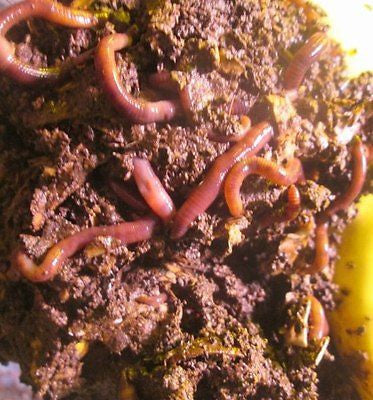Efficient red worms: Perfect for sustainable gardening
Efficient red worms: Perfect for sustainable gardening
Blog Article
Boost Soil Health Naturally With Red Wigglers
The assimilation of red wigglers into dirt monitoring practices presents a compelling method for improving dirt wellness normally. These earthworms not only transform natural waste right into valuable vermicompost, but their natural actions also advertise boosted dirt framework, aeration, and nutrition accessibility.
Benefits of Red Wigglers

Furthermore, red wigglers boost dirt framework by creating channels as they tunnel through the earth. This task improves oygenation and drainage, assisting in origin growth and making sure that plants obtain ample oxygen and wetness. Furthermore, the spreadings generated by red wigglers are high in nutrients such as nitrogen, phosphorus, and potassium, which are important for plant development.
Red wigglers likewise aid in the decrease of hazardous pathogens and pests by outcompeting them for resources, even more adding to a much healthier dirt environment. Their visibility can cause a decrease in the need for artificial plant foods and pesticides, advertising sustainable farming practices. Generally, incorporating red wigglers into soil administration approaches provides an all-natural and reliable ways of improving soil vigor, therefore supporting durable plant development and agricultural performance.
Establishing Up Vermicomposting
Developing a vermicomposting system is a sensible means to harness the impressive benefits of red wigglers in boosting soil health. red wigglers. To start, choose an ideal container-- ideally, a plastic or wood container with a cover to keep moisture and temperature level. The container should have drain openings to prevent excess water build-up
Following, prepare bed linen material, which acts as an environment for the worms. Suitable products consist of shredded newspaper, cardboard, or coconut coir. Purpose for a depth of 4-6 inches to provide appropriate area for the worms.
When the bedding remains in place, introduce the red wigglers, generally at a proportion of one extra pound of worms for each square foot of surface location in the bin. Following this, add cooking area scraps such as vegetables and fruit peels, coffee premises, and crushed eggshells. Prevent meat, dairy, and oily foods, as these can attract parasites.
(Worm Farms Near Me)
Taking Care Of Your Worms
Maintaining the well-being of your red wigglers is necessary for a thriving vermicomposting system. Appropriate treatment makes certain that these beneficial organisms can effectively break down organic matter and enhance your soil. Begin by providing an ideal environment; a well-ventilated container with a wet, dark setting is critical. Go for a bed linens material that consists of shredded newspaper, cardboard, or coconut coir, which should be maintained wet however not saturated.
Feeding your worms is an additional essential facet of their care. Red wigglers thrive on kitchen scraps such as vegetables and fruit peels, coffee grounds, and smashed eggshells. Prevent feeding them citrus fruits, onions, and milk products, as these can create an unwelcoming environment. navigate to these guys Display the quantity of food you supply to avoid overfeeding, which can bring about odor issues and attract pests.
Temperature level monitoring is important; worms like an array of 55 to 77 levels Fahrenheit. By following these guidelines, you will cultivate a healthy and balanced ecological community for your red wigglers.
Utilizing Worm Spreadings in Soil
Worm castings, typically referred to as "black gold," are an effective modification that can dramatically improve dirt health and wellness and fertility. red wigglers. These nutrient-rich, organic fertilizers are created by red wigglers throughout their food digestion process, leading to a finely distinctive material that is beneficial for plants and soil alike
Integrating worm spreadings into your dirt improves its framework, improving aeration and water retention. This is especially advantageous for sandy dirts that drain pipes also quickly, as well as heavy clay dirts that can end up being compacted. In addition, worm spreadings are packed with essential nutrients, consisting of nitrogen, phosphorus, and potassium, which are essential for plant growth.

Eventually, using worm spreadings cultivates a successful ecological community within the soil, bring about much healthier plants and more sustainable gardening methods.
Tips for Effective Composting
Effective composting needs mindful interest to a couple of crucial concepts that can significantly boost the high quality of the end product. Equilibrium is important; maintain a correct ratio of green materials (nitrogen-rich) to brown products (carbon-rich), preferably around 1:3. This balance promotes reliable disintegration and decreases smells.
2nd, aeration plays a crucial duty. Consistently turning the compost heap enhances oxygen flow, which speeds up microbial task and quicken the composting procedure. Go for a stack dimension of at the very least 3 feet by 3 feet to maintain heat, which even more advertises disintegration.
(Raleigh Worm Farms)
Dampness material is one more important aspect; the garden compost must be wet but not soggy. A good general rule is to attain a dampness level comparable to that of a wrung-out sponge. Too much water can result in anaerobic problems, while insufficient can reduce decomposition.
Lastly, monitor the temperature of the compost. A temperature level series of 130 ° F to 160 ° F suggests energetic composting and helps eliminate pathogens and weed seeds. By adhering to these concepts, you will create a nutrient-rich compost that sustains soil health and wellness and improves plant development.
Verdict
Incorporating red wigglers right into horticulture techniques enhances soil health and wellness via all-natural procedures. These worms contribute to the break down of organic materials, resulting in nutrient-rich vermicompost that improves dirt structure and fertility.
Report this page